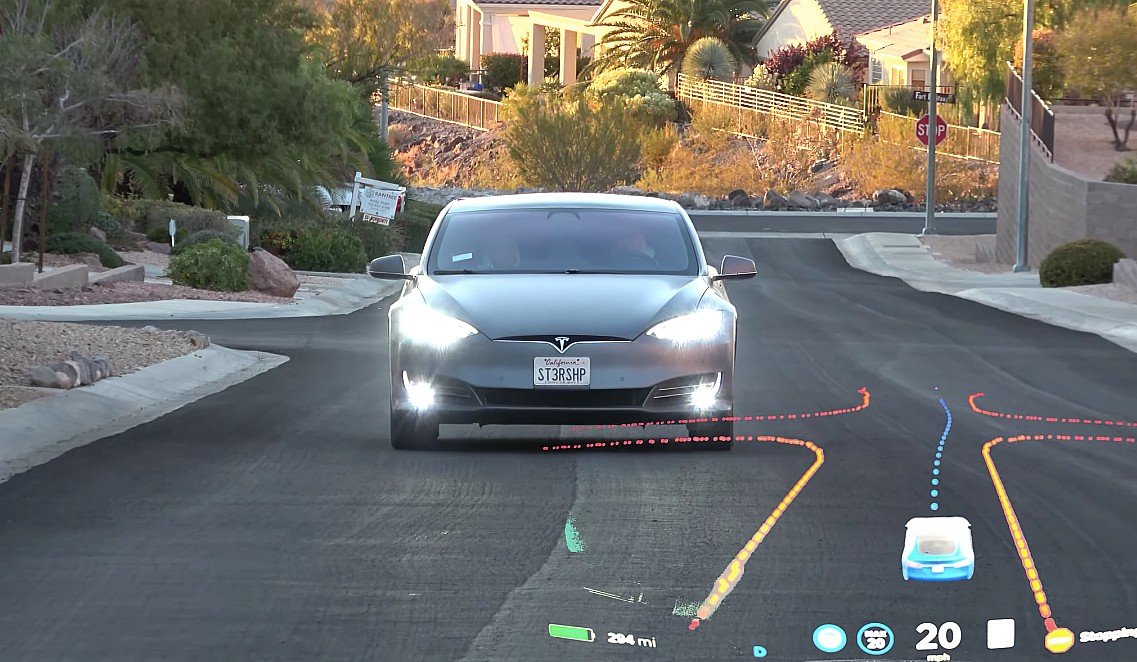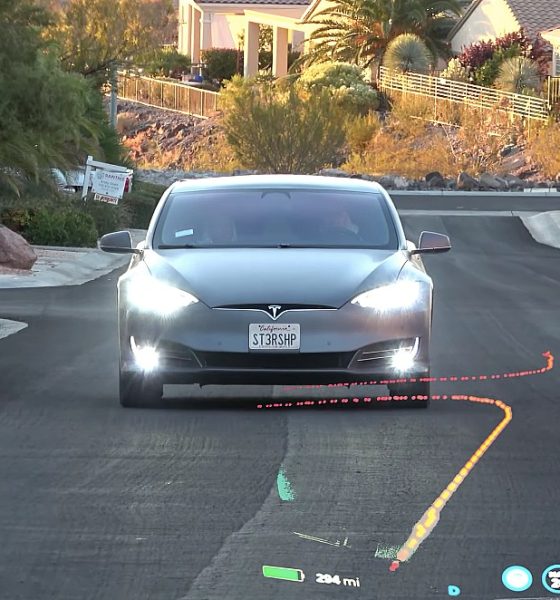

News
Elon Musk explains Tesla’s pure vision approach to Autopilot and Full Self-Driving
A recent set of updates from Elon Musk has revealed that Tesla is looking to eventually update its Autopilot and Full Self-Driving suite to a camera-based system. This means that in the future, Tesla’s all-electric vehicles would be navigating themselves and performing driver-assist functions without the use of components such as radar.
Musk’s update came as a response to a post from Tesla owner and FSD Beta user @WholeMarsBlog, who shared a clip of his Model 3 navigating away from a parking lot to its destination without input from its driver. In his response, Musk noted that FSD Beta V9.0, which has been highly-anticipated by the EV community, is almost ready.
Almost ready with FSD Beta V9.0. Step change improvement is massive, especially for weird corner cases & bad weather. Pure vision, no radar.
— Elon Musk (@elonmusk) April 9, 2021
Elaborating further, Musk explained that the V9.0 update should improve the FSD Beta’s performance in corner cases and bad weather, which remain challenging to the advanced driver-assist system today. But this was not all, as Musk noted that the update would be “pure vision, no radar.” When prodded further, the Tesla CEO admitted that Tesla eventually plans to get rid of radar altogether in its future vehicles.
Unsurprisingly, Musk’s statements about Tesla’s impending removal of radar attracted its own fair share of critics, many of whom argued that a pure vision approach is a step backward. This is especially notable as Tesla is already using fewer sensors for its driver-assist systems compared to competitors like Cruise and Waymo, both of whom rely on lidar and high-definition maps to navigate.
Musk responded to these concerns, highlighting that ultimately, vision has the potential to be far superior to radar.
Sensors are a bitstream and cameras have several orders of magnitude more bits/sec than radar (or lidar).
Radar must meaningfully increase signal/noise of bitstream to be worth complexity of integrating it.
As vision processing gets better, it just leaves radar far behind.
— Elon Musk (@elonmusk) April 10, 2021
“When radar and vision disagree, which one do you believe? Vision has much more precision, so better to double down on vision than do sensor fusion. Sensors are a bitstream and cameras have several orders of magnitude more bits/sec than radar (or lidar). Radar must meaningfully increase signal/noise of bitstream to be worth complexity of integrating it. As vision processing gets better, it just leaves radar far behind,” Musk explained.
Tesla’s approach to full self-driving is partly based on the notion that humans do 100% of their driving through vision alone, without any radar or lidar use. This was highlighted by Tesla executives since Autonomy Day back in 2019, when the company unveiled its custom FSD computer. As for concerns about whether cameras could provide the same level of safety as radar in detecting what is happening several cars ahead, Musk noted that there’s a high probability that vision could perform just as well.
These things are best thought of as probabilities. There are 5 forward-facing cameras. It is highly likely that at least one of them will see multiple cars ahead.
— Elon Musk (@elonmusk) April 10, 2021
“These things are best thought of as probabilities. There are 5 forward-facing cameras. It is highly likely that at least one of them will see multiple cars ahead,” Musk said.
Tesla is not the only company in the market that is looking into a vision-only approach. Last year, Intel Corp released a video of an autonomous car from MobilEye that was navigating around Jerusalem for about 20 minutes. Unlike other self-driving vehicles, MobilEye’s car was only equipped with a suite of cameras and nothing else. The brief video was impressive, showing the MobilEye autonomous car going through four-way intersections with no traffic lights, as well as inner-city lanes that required the vehicle to avoid pedestrians.
Don’t hesitate to contact us for news tips. Just send a message to tips@teslarati.com to give us a heads up.

News
Tesla FSD fleet is nearing 7 billion total miles, including 2.5 billion city miles
As can be seen on Tesla’s official FSD webpage, vehicles equipped with the system have now navigated over 6.99 billion miles.

Tesla’s Full Self-Driving (Supervised) fleet is closing in on almost 7 billion total miles driven, as per data posted by the company on its official FSD webpage.
These figures hint at the massive scale of data fueling Tesla’s rapid FSD improvements, which have been quite notable as of late.
FSD mileage milestones
As can be seen on Tesla’s official FSD webpage, vehicles equipped with the system have now navigated over 6.99 billion miles. Tesla owner and avid FSD tester Whole Mars Catalog also shared a screenshot indicating that from the nearly 7 billion miles traveled by the FSD fleet, more than 2.5 billion miles were driven inside cities.
City miles are particularly valuable for complex urban scenarios like unprotected turns, pedestrian interactions, and traffic lights. This is also the difference-maker for FSD, as only complex solutions, such as Waymo’s self-driving taxis, operate similarly on inner-city streets. And even then, incidents such as the San Francisco blackouts have proven challenging for sensor-rich vehicles like Waymos.
Tesla’s data edge
Tesla has a number of advantages in the autonomous vehicle sector, one of which is the size of its fleet and the number of vehicles training FSD on real-world roads. Tesla’s nearly 7 billion FSD miles then allow the company to roll out updates that make its vehicles behave like they are being driven by experienced drivers, even if they are operating on their own.
So notable are Tesla’s improvements to FSD that NVIDIA Director of Robotics Jim Fan, after experiencing FSD v14, noted that the system is the first AI that passes what he described as a “Physical Turing Test.”
“Despite knowing exactly how robot learning works, I still find it magical watching the steering wheel turn by itself. First it feels surreal, next it becomes routine. Then, like the smartphone, taking it away actively hurts. This is how humanity gets rewired and glued to god-like technologies,” Fan wrote in a post on X.
News
Tesla starts showing how FSD will change lives in Europe
Local officials tested the system on narrow country roads and were impressed by FSD’s smooth, human-like driving, with some calling the service a game-changer for everyday life in areas that are far from urban centers.

Tesla has launched Europe’s first public shuttle service using Full Self-Driving (Supervised) in the rural Eifelkreis Bitburg-Prüm region of Germany, demonstrating how the technology can restore independence and mobility for people who struggle with limited transport options.
Local officials tested the system on narrow country roads and were impressed by FSD’s smooth, human-like driving, with some calling the service a game-changer for everyday life in areas that are far from urban centers.
Officials see real impact on rural residents
Arzfeld Mayor Johannes Kuhl and District Administrator Andreas Kruppert personally tested the Tesla shuttle service. This allowed them to see just how well FSD navigated winding lanes and rural roads confidently. Kruppert said, “Autonomous driving sounds like science fiction to many, but we simply see here that it works totally well in rural regions too.” Kuhl, for his part, also noted that FSD “feels like a very experienced driver.”
The pilot complements the area’s “Citizen Bus” program, which provides on-demand rides for elderly residents who can no longer drive themselves. Tesla Europe shared a video of a demonstration of the service, highlighting how FSD gives people their freedom back, even in places where public transport is not as prevalent.
What the Ministry for Economic Affairs and Transport says
Rhineland-Palatinate’s Minister Daniela Schmitt supported the project, praising the collaboration that made this “first of its kind in Europe” possible. As per the ministry, the rural rollout for the service shows FSD’s potential beyond major cities, and it delivers tangible benefits like grocery runs, doctor visits, and social connections for isolated residents.
“Reliable and flexible mobility is especially vital in rural areas. With the launch of a shuttle service using self-driving vehicles (FSD supervised) by Tesla in the Eifelkreis Bitburg-Prüm, an innovative pilot project is now getting underway that complements local community bus services. It is the first project of its kind in Europe.
“The result is a real gain for rural mobility: greater accessibility, more flexibility and tangible benefits for everyday life. A strong signal for innovation, cooperation and future-oriented mobility beyond urban centers,” the ministry wrote in a LinkedIn post.
News
Tesla China quietly posts Robotaxi-related job listing
Tesla China is currently seeking a Low Voltage Electrical Engineer to work on circuit board design for the company’s autonomous vehicles.

Tesla has posted a new job listing in Shanghai explicitly tied to its Robotaxi program, fueling speculation that the company is preparing to launch its dedicated autonomous ride-hailing service in China.
As noted in the listing, Tesla China is currently seeking a Low Voltage Electrical Engineer to work on circuit board design for the company’s autonomous vehicles.
Robotaxi-specific role
The listing, which was shared on social media platform X by industry watcher @tslaming, suggested that Tesla China is looking to fill the role urgently. The job listing itself specifically mentions that the person hired for the role will be working on the Low Voltage Hardware team, which would design the circuit boards that would serve as the nervous system of the Robotaxi.
Key tasks for the role, as indicated in the job listing, include collaboration with PCB layout, firmware, mechanical, program management, and validation teams, among other responsibilities. The role is based in Shanghai.
China Robotaxi launch
China represents a massive potential market for robotaxis, with its dense urban centers and supportive policies in select cities. Tesla has limited permission to roll out FSD in the country, though despite this, its vehicles have been hailed as among the best in the market when it comes to autonomous features. So far, at least, it appears that China supports Tesla’s FSD and Robotaxi rollout.
This was hinted at in November, when Tesla brought the Cybercab to the 8th China International Import Expo (CIIE) in Shanghai, marking the first time that the autonomous two-seater was brought to the Asia-Pacific region. The vehicle, despite not having a release date in China, received a significant amount of interest among the event’s attendees.








